Ariston ARXXL105 User Manual [es]

Instructions for use
WASHING MACHINE
|
|
|
|
|
|
|
|
|
|
|
|
|
|
|
|
|
|
|
|
Contents |
|
||
|
|
|
|
|
|
|
|
GB |
|||
|
|
|
|
|
|
|
|
|
|
||
|
|
|
|
|
|
|
|
Installation, 2-3 |
|
||
GB |
|
|
GR |
|
|
RO |
|
|
|||
|
|
|
|
|
Unpacking and levelling |
||||||
|
|
|
|
|
|
|
|
Connecting the electricity and water supplies |
|||
English,1 |
ЕЛЛЗНЙКБ,13 |
Românã,25 |
|||||||||
The first wash cycle |
|||||||||||
|
|
|
|
|
|
|
|
Technical data |
|||
ES PT
Español,37 Português,49
Description of the washing machine and starting a wash cycle, 4-5
Control panel Indicator lights Starting a wash cycle
ARXXL 105
Wash cycles, 6
Table of wash cycles
Personalisation, 7
Setting the temperature
Setting the spin speed
Functions
Detergents and laundry, 8
Detergent dispenser drawer Bleach cycle
Preparing the laundry Garments requiring special care Load balancing system
Precautions and tips, 9
General safety Disposal
Opening the porthole door manually
Care and maintenance, 10
Cutting off the water or electricity supply Cleaning the washing machine
Cleaning the detergent dispenser drawer Caring for the door and drum of your appliance Cleaning the pump
Checking the water inlet hose
Troubleshooting, 11
Service, 12
1
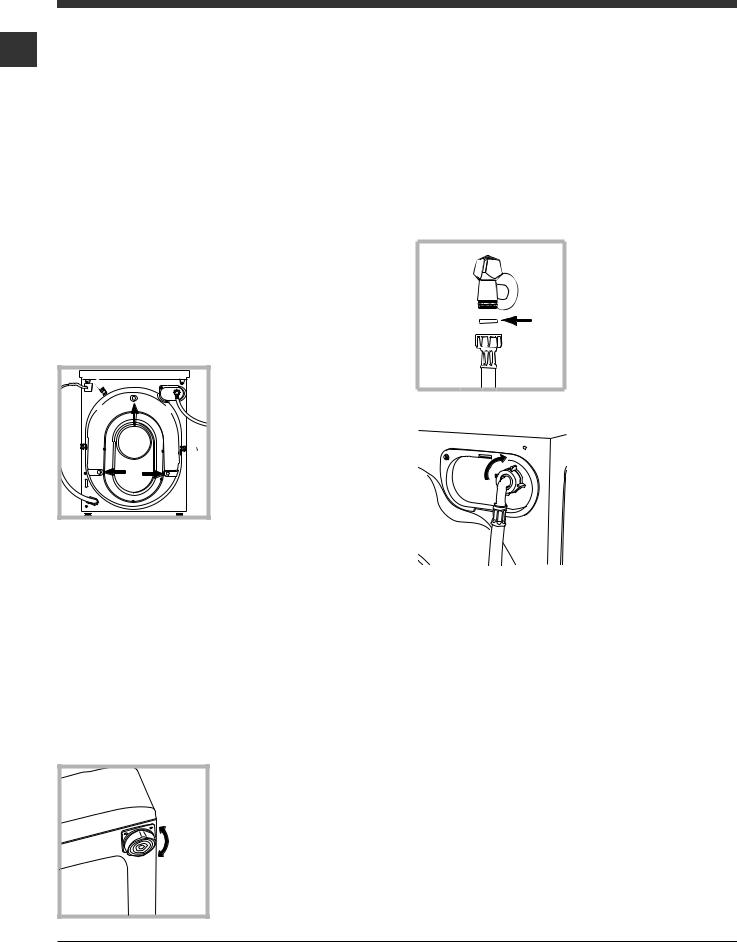
Installation
This instruction manual should be kept in a safe GB place for future reference. If the washing machine is
sold, transferred or moved, make sure that the instruction manual remains with the machine so that the new owner is able to familiarise himself/herself with its operation and features.
Read these instructions carefully: they contain vital information relating to the safe installation and operation of the appliance.
Unpacking and levelling
Unpacking
1.Remove the washing machine from its packaging.
2.Make sure that the washing machine has not been damaged during the transportation process. If it has been damaged, contact the retailer and do not proceed any further with the installation process.
3. Remove the 3 protective screws (used during transportation) and the rubber washer with the corresponding spacer, located on the rear part of the appliance (see figure).
4.Close off the holes using the plastic plugs provided.
5.Keep all the parts in a safe place: you will need them again if the washing machine needs to be moved to another location.
Packaging materials should not be used as toys for children.
Levelling
1. Install the washing machine on a flat sturdy floor, without resting it up against walls, furniture cabinets or anything else.
2. If the floor is not perfectly level, compensate for any unevenness by tightening or loosening the adjustable front feet (see figure); the angle of inclination, measured in relation to the worktop, must not exceed 2°.
Levelling the machine correctly will provide it with stability, help to avoid vibrations and excessive noise and prevent it from shifting while it is operating. If it is placed on carpet or a rug, adjust the feet in such a way as to allow a sufficient ventilation space underneath the washing machine.
Connecting the electricity and water supplies
Connecting the water inlet hose
1. Insert seal A into the end of the inlet hose and screw the latter onto a cold water tap with a 3/4 gas threaded opening
|
|
A |
(see figure). |
|
|
|
|
|
|
|
Before performing the |
|
|
|
connection, allow the |
|
|
|
|
|
|
|
water to run freely until it |
|
|
|
is perfectly clear. |
|
|
|
2. Connect the inlet hose |
|
|
|
|
|
|
|
to the washing machine |
|
|
|
by screwing it onto the |
|
|
|
corresponding water inlet |
|
|
|
of the appliance, which is |
|
|
|
situated on the top right- |
|
|
|
hand side of the rear part |
|
|
|
of the appliance (see |
|
|
|
figure). |
|
|
|
|
3. Make sure that the hose is not folded over or bent.
The water pressure at the tap must fall within the values indicated in the Technical details table (see next page).
If the inlet hose is not long enough, contact a specialised shop or an authorised technician.
Never use second-hand hoses.
Use the ones supplied with the machine.
2

Connecting the drain hose
65 - 100 cm |
Connect the drain hose, without bending it, to a drainage duct or a wall drain located at a height between 65 and 100 cm from the floor;
alternatively, rest it on the side of a washbasin or bathtub, fastening the duct supplied to the tap (see figure). The free end of the hose should not be underwater.
We advise against the use of hose extensions; if it is absolutely necessary, the extension must have the same diameter as the original hose and must not exceed 150 cm in length.
Electrical connections
Before plugging the appliance into the electricity socket, make sure that:
•the socket is earthed and complies with all applicable laws;
•the socket is able to withstand the maximum power load of the appliance as indicated in the Technical data table (see opposite);
•the power supply voltage falls within the values indicated in the Technical data table (see opposite);
•the socket is compatible with the plug of the washing machine. If this is not the case, replace the socket or the plug.
The washing machine must not be installed outdoors, even in covered areas. It is extremely dangerous to leave the appliance exposed to rain, storms and other weather conditions.
When the washing machine has been installed, the electricity socket must be within easy reach.
Do not use extension cords or multiple sockets.
GB
The cable should not be bent or compressed.
The power supply cable must only be replaced by authorised technicians.
Warning! The company shall not be held responsible in the event that these regulations are not respected.
The first wash cycle
Once the appliance has been installed, and before you use it for the first time, run a wash cycle with detergent and no laundry, using the wash cycle 1.
Technical data
Model |
ARXXL 105 |
|||
|
|
|
|
|
|
|
|
width 59.5 cm |
|
Dimensions |
height 85 cm |
|||
|
|
|
depth 56,5 cm |
|
|
|
|
|
|
Capacity |
from 1 to 7 kg |
|||
|
|
|
|
|
Electrical |
please refer to the technical data |
|||
connections |
plate fixed to the machine |
|||
|
|
|
|
|
|
|
|
maximum pressure 1 MPa (10 bar) |
|
Water connections |
minimum pressure 0.05 MPa (0.5 bar) |
|||
|
|
|
drum capacity 52 litres |
|
|
|
|
|
|
Spin speed |
up to 1000 rotations per minute |
|||
|
|
|
|
|
Energy rated |
|
|||
programmes |
programme 6; temperature 60°C; |
|||
according to |
||||
using a load of 7 kg. |
||||
regulation |
||||
|
||||
EN 60456 |
|
|||
|
|
|
|
|
|
|
|
This appliance conforms to the |
|
|
|
|
following EC Directives: |
|
|
|
|
- 72/23/EEC dated 19/02/73 (Low |
|
|
|
|
Voltage) and subsequent modifications |
|
|
|
|
- 89/336/EEC dated 03/05/89 |
|
|
|
|
(Electromagnetic Compatibility) and |
|
|
|
|
subsequent modifications |
|
|
|
|
- 2002/96/EC |
|
|
|
|
||
|
|
|
||
3
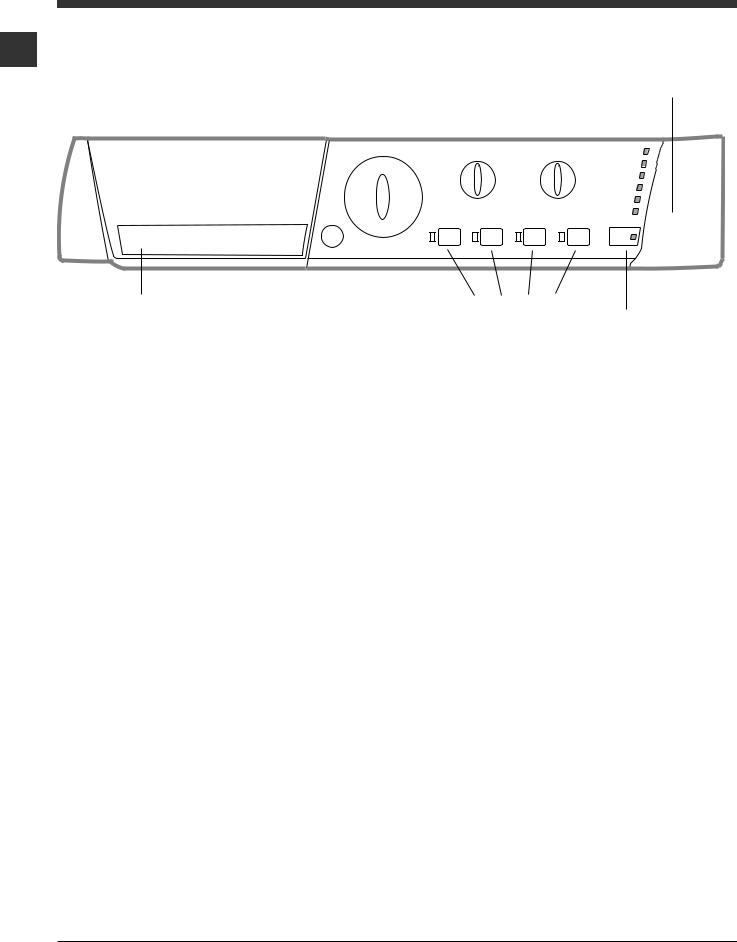
Description of the washing machine and starting a wash cycle
Control panel
GB
|
|
|
|
|
|
|
WASH CYCLE PROGRESS/ |
||||||||||
|
|
|
|
|
|
|
DELAY TIMER indicator lights |
||||||||||
|
|
|
|
|
|
|
|
|
|
|
|
|
|||||
|
|
|
SPIN SPEED |
|
|
|
|
|
|
|
|
|
|
||||
|
|
|
|
|
|
|
|
|
|
|
|
|
|||||
ON/OFF button |
|
|
|
|
|
|
knob |
|
|
|
|
|
|
|
|
|
DOOR |
|
|
|
|
|
|
|
|
|
|
|
|
|
|||||
|
TEMPERATURE |
|
|
|
|
|
|
|
|
|
|
|
|
LOCKED |
|||
|
|
|
|
|
|
||||||||||||
|
|
|
knob |
|
|
|
|
|
|
|
|
|
|
|
|
indicator light |
|
|
|
|
|
|
|
|
|
|
|
|
|
|
|
|
|
|
|
|
|
|
|
|
|
|
|
|
|
|
|
|
|
|
|
|
|
|
|
|
|
|
|
|
|
|
|
|
|
|
|
|
|
|
|
|
|
|
|
|
|
|
|
|
|
|
|
|
|
|
|
|
|
|
|
|
|
|
|
|
|
|
|
|
|
|
|
|
|
|
|
|
|
|
|
|
|
|
|
|
|
|
|
|
|
|
|
|
|
|
|
|
|
|
|
|
|
|
|
|
|
|
|
|
|
|
|
|
|
|
|
|
|
|
|
|
|
|
|
|
|
|
|
|
|
|
|
|
|
|
|
|
|
|
|
|
|
|
|
|
|
|
|
|
|
|
|
|
|
|
|
|
|
|
|
|
|
|
|
|
|
|
|
|
START/PAUSE |
Detergent dispenser drawer |
|
||
|
button with indicator |
||
|
|
|
|
|
|
FUNCTION |
light |
WASH CYCLE |
buttons with |
|
|
indicator lights |
|
||
|
knob |
|
|
Detergent dispenser drawer: used to dispense detergents and washing additives (see “Detergents and laundry”).
There is a key which provides a summary of the available wash cycles inside the detergent dispenser drawer; this may be consulted at any time.
ON/OFF button: switches the washing machine on and off.
WASH CYCLE knob: programmes the wash cycles. During the wash cycle, the knob does not move.
FUNCTION buttons with indicator light: used to select the available functions. The indicator light corresponding to the selected function will remain lit.
TEMPERATURE knob: sets the temperature or the cold wash cycle (see “Personalisation”).
SPIN SPEED knob: sets the spin speed or exclude the spin cycle completely (see “Personalisation”).
WASH CYCLE PROGRESS/DELAY TIMER indicator lights: used to monitor the progress of the wash cycle.
The illuminated indicator light shows which phase is in progress.
If the Delay Timer function has been set, the time remaining until the wash cycle starts will be indicated
(see next page).
DOOR LOCKED indicator light: indicates whether the door may be opened or not (see next page).
START/PAUSE button with indicator light: starts or temporarily interrupts the wash cycles.
N.B. To pause the wash cycle in progress, press this button; the corresponding indicator light will flash orange, while the indicator light for the current wash cycle phase will remain lit in a fixed manner. If the DOOR LOCKED  indicator light is switched off, the door may be opened.
indicator light is switched off, the door may be opened.
To start the wash cycle from the point at which it was interrupted, press this button again.
4
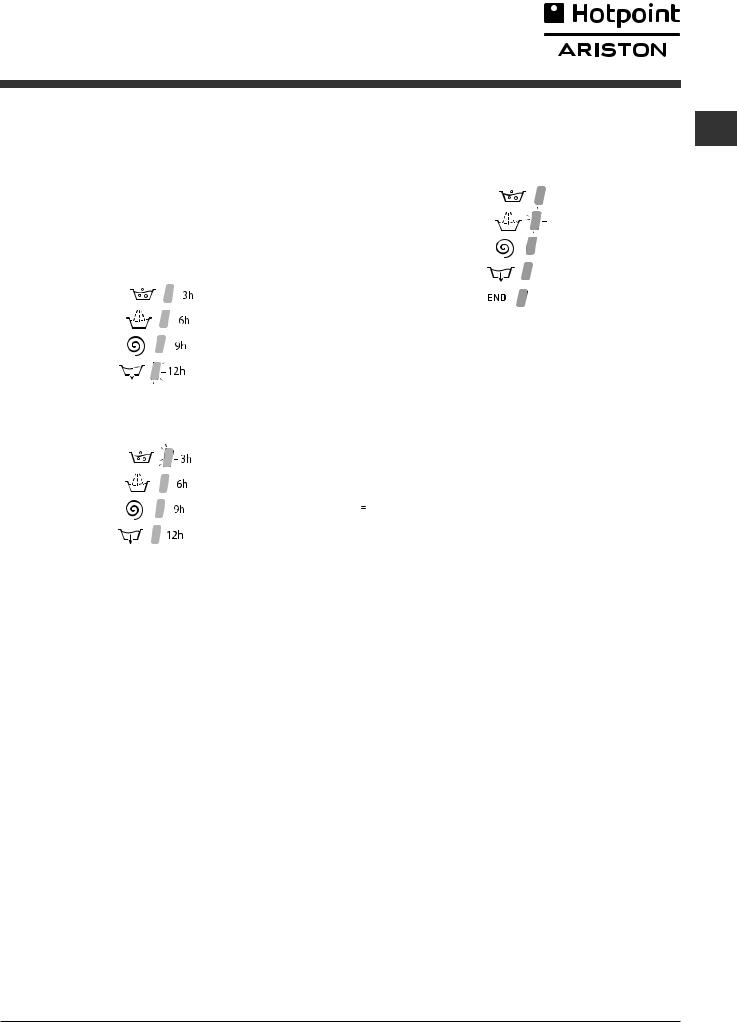
Indicator lights
The indicator lights provide important information. This is what they can tell you:
Delayed start
If the DELAY TIMER function has been activated (see “Personalisation”), after the wash cycle has been started the indicator light corresponding to the selected delay period will begin to flash:
As time passes, the remaining delay will be displayed and the corresponding indicator light will flash:
Once the set delay has elapsed, the flashing indicator light will switch off and the selected wash cycle will begin.
Starting a wash cycle
Wash cycle phase indicator lights
Once the desired wash cycle has been selected and has GB begun, the indicator lights switch on one by one to
indicate which phase of the cycle is currently in progress.
Wash
Rinse
Spin
Drain
End of wash cycle
Function buttons and corresponding indicator lights
When a function is selected, the corresponding indicator light will illuminate.
If the selected function is not compatible with the programmed wash cycle, the corresponding indicator light will flash and the function will not be activated. If a function which is incompatible with another function selected previously, only the most recent selection will remain active.
 Door locked indicator light
Door locked indicator light
If this indicator light is on, the appliance door is locked to prevent it from being opened accidentally; to avoid any damage, wait for the indicator light to switch off before you open the appliance door.
N.B. If the DELAY TIMER function is activated, the door cannot be opened; pause the machine by pressing the START/PAUSE button if you wish to open it.
If the START/PAUSE indicator light (orange) flashes rapidly at the same time as the function indicator light, this indicates a problem has occurred (see “Troubleshooting”).
1.Switch the washing machine on by pressing the ON/OFF button. All indicator lights will switch on for a few seconds, then they will switch off and the START/PAUSE indicator light will pulse.
2.Load the laundry and close the door.
3.Set the WASH CYCLE knob to the desired programme.
4.Set the washing temperature (see “Personalisation”).
5.Set the spin speed (see “Personalisation”).
6.Measure out the detergent and washing additives (see “Detergents and laundry”).
7.Select the desired functions.
8.Start the wash cycle by pressing the START/PAUSE button and the corresponding indicator light will remain lit in a fixed manner, in green.
To cancel the set wash cycle, pause the machine by pressing the START/PAUSE button and select a new cycle.
9. At the end of the wash cycle the 
 indicator light will switch on. The DOOR LOCKED indicator light will switch off, indicating that the door may be opened. Take out your laundry and leave the appliance door ajar to make sure the drum dries completely.
indicator light will switch on. The DOOR LOCKED indicator light will switch off, indicating that the door may be opened. Take out your laundry and leave the appliance door ajar to make sure the drum dries completely.
Switch the washing machine off by pressing the ON/OFF button.
5

Wash cycles
Table of wash cycles
GB |
|
|
|
|
|
|
|
|
|
|
|
|
cycles |
|
Max |
Max. |
|
Detergents |
|
Max. |
Cycle |
||
|
|
|
|
|
|||||||
|
|
|
|
|
|
|
|||||
|
|
|
|
|
|
|
|
|
|||
|
|
Wash |
Description of the wash cycle |
temp. |
speed |
|
|
|
|
load |
duration |
|
|
|
|
|
softener |
||||||
|
|
|
|
(°C) |
(rpm) |
|
|
|
Fabric |
(kg) |
|
|
|
|
|
Bleach |
Wash |
|
|
||||
|
|
|
|
|
|
|
|
|
|
||
|
|
|
|
|
|
|
|
|
|
|
|
|
|
|
Special cycles |
|
|
|
|
|
|
|
|
|
6 |
Sanitizing cycle: Extremely soiled whites. |
90° |
1000 |
l |
l |
|
l |
7 |
165 |
|
|
|
|
|
|
|
|
|
|
|
|
|
|
6 |
Sanitizing cycle (1): Heavily soiled whites and resistant colours. |
60° |
1000 |
- |
l |
|
l |
7 |
175 |
|
|
|
|
|
|
|
|
|
|
|
|
|
|
7 |
Goodnigt cycle: Lightly soiled delicate colours. |
40° |
800 |
- |
l |
|
l |
4 |
290 |
|
|
|
|
|
|
|
|
|
|
|
|
|
|
8 |
Baby cycle: Heavily soiled delicate colours. |
40° |
800 |
- |
l |
|
l |
2 |
118 |
|
|
|
|
|
|
|
|
|
|
|
|
|
|
9 |
Shirts |
40° |
600 |
- |
l |
|
l |
2 |
70 |
|
|
|
|
|
|
|
|
|
|
|
|
|
|
10 |
Silk/Curtains: For garments in silk and viscose, lingerie. |
30° |
0 |
- |
l |
|
l |
2 |
55 |
|
|
|
|
|
|
|
|
|
|
|
|
|
|
|
11 |
Wool: For wool, cashmere, etc. |
40° |
600 |
- |
l |
|
l |
1,5 |
55 |
|
|
|
|
|
|
|
|
|
|
|
|
|
|
|
Everyday wash cycles (Daily) |
|
|
|
|
|
|
|
|
|
1 |
Cotton: Heavily soiled whites and resistant colours. |
60° |
1000 |
l |
l |
|
l |
7 |
130 |
|
|
|
|
|
|
|
|
|
|
|
|
|
|
1 |
Cotton (2): Heavily soiled whites and delicate colours. |
40° |
1000 |
l |
l |
|
l |
7 |
115 |
|
|
|
|
|
|
|
|
|
|
|
|
|
|
2 |
Coloured Cottons (3): Lightly soiled whites and delicate colours. |
40° |
1000 |
l |
l |
|
l |
7 |
85 |
|
|
|
|
|
|
|
|
|
|
|
|
|
|
3 |
Synthetics resistents: Heavily soiled resistant colours. |
60° |
800 |
- |
l |
|
l |
3 |
85 |
|
|
|
|
|
|
|
|
|
|
|
|
|
|
3 |
Synthetics delicates: Lightly soiled resistant colours. |
40° |
800 |
- |
l |
|
l |
3 |
70 |
|
|
|
|
|
|
|
|
|
|
|
|
|
|
|
4 |
Mix 30': To refresh lightly soiled garments quickly (not suitable |
30° |
800 |
- |
l |
|
l |
3 |
30 |
|
for wool, silk and clothes which require washing by hand). |
|
|||||||||
|
|
5 |
Mix 15': To refresh lightly soiled garments quickly (not suitable |
30° |
800 |
- |
l |
|
l |
1,5 |
15 |
|
for wool, silk and clothes which require washing by hand). |
|
|||||||||
|
|
|
Partial wash cycles |
|
|
|
|
|
|
|
|
|
|
A |
Rinse |
- |
1000 |
- |
- |
|
l |
7 |
44 |
|
|
|
|
|
|
|
|
|
|
|
|
|
|
B |
Light rinse |
- |
800 |
- |
- |
|
l |
3 |
37 |
|
|
|
|
|
|
|
|
|
|
|
|
|
|
C |
Spin |
- |
1000 |
- |
- |
|
- |
7 |
16 |
|
|
|
|
|
|
|
|
|
|
|
|
|
|
D |
Light spin |
- |
800 |
- |
- |
|
- |
3 |
12 |
|
|
|
|
|
|
|
|
|
|
|
|
|
|
E |
Drain no spin |
- |
0 |
- |
- |
|
- |
7 |
2 |
|
|
|
|
|
|
|
|
|
|
|
|
The information contained in the table is intended as a guide only.
For all Test Institutes:
1)Test wash cycle in compliance with regulation EN 60456: set wash cycle 6 with a temperature of 60°C.
2)Long wash cycle for cottons: set wash cycle 1 with a temperature of 40°C.
3)Short wash cycle for cottons: set wash cycle 2 with a temperature of 40°C.
Specials wash cycles
Sanitizing cycle (wash cycle 6). A high-temperature hygienic wash cycle (over 60°C) which requires the use of bleach. Pour the bleach, the detergent and the additives into the relevant compartments (see paragraph entitled
“Detergent dispenser drawer”).
Goodnigt cycle (wash cycle 7). This is a silent cycle which can be run at night, when the electricity prices are lower. The wash cycle is designed for cottons and synthetics. At the end of the cycle the machine stops while there is still water in the drum; to spin and drain the laundry press the START/PAUSE button; alternatively the machine will perform the spin cycle and drain the water automatically after 8 hours.
Baby cycle (wash cycle 8). This wash cycle can be used to remove the soiling typically caused by babies, while ensuring that all detergent is removed from nappies in order to prevent the delicate skin of babies from suffering allergies. The cycle has been designed to reduce the amount of bacteria by using a greater quantity of water and optimising the effect of special disinfecting additives added to the detergent.
At the end of the wash cycle, the machine will slowly rotate the drum to prevent the formation of creases; to end the cycle press the START/PAUSE button.
Mix 30’ (wash cycle 4) this wash cycle was designed to wash lightly soiled garments quickly: it lasts just 30 minutes and therefore saves both energy and time. By selecting this wash cycle (4 at 30°C), it is possible to wash different fabrics together (except for wool and silk items), with a maximum load of 3 kg.
Mix 15’(wash cycle 5) this wash cycle was designed to wash lightly soiled garments quickly: it lasts just 15 minutes and therefore saves both energy and time. By selecting this wash cycle (5 at 30°C), it is possible to wash different fabrics together (except for wool and silk items), with a maximum load of 1.5 kg.
6

Personalisation
Setting the temperature
Turn the TEMPERATURE knob to set the wash temperature (see Table of wash cycles). |
GB |
|
|
The temperature may be lowered, or even set to a cold wash ( ). |
|
The washing machine will automatically prevent you from selecting a temperature which is higher than the |
|
maximum value set for each wash cycle. |
|
Setting the spin speed
Turn the SPIN SPEED knob to set the spin speed for the selected wash cycle.
The maximum spin speeds available for each wash cycle are as follows:
Wash cycles |
Maximum spin speed |
Cottons |
1000 rpm |
Synthetics |
800 rpm |
Wool |
600 rpm |
Silk |
drain only |
The spin speed may be lowered, or the spin cycle can be excluded altogether by selecting the symbol  . The washing machine will automatically prevent you from selecting a spin speed which is higher than the maximum speed set for each wash cycle.
. The washing machine will automatically prevent you from selecting a spin speed which is higher than the maximum speed set for each wash cycle.
Functions
The various wash functions available with this washing machine will help to achieve the desired results, every time. To activate the functions:
1.Press the button corresponding to the desired function;
2.the function is enabled when the corresponding indicator light is illuminated.
Note: If the indicator light flashes rapidly, this signals that this particular function may not be selected in conjunction with the selected wash cycle.
 Delay timer
Delay timer
This timer delays the start time of the wash cycle by up to 12 hours.
Press the button repeatedly until the indicator light corresponding to the desired delay time switches on. The fifth time the button is pressed, the function will be disabled.
N.B. Once you have pressed the START/PAUSE button, the delay time may only be decreased if you wish to modify it.
This option is enabled with all programmes.
 Easy iron
Easy iron
By selecting this function, the wash and spin cycles will be modified in order to reduce the formation of creases. At the end of the cycle the washing machine will perform slow rotations of the drum; the EASY IRON and START/ PAUSE indicator lights will flash (orange) and the RINSE phase will remain lit in a fixed manner. To end the cycle, press the START/PAUSE button or the EASY IRON button.
For the Silk (10) wash cycle, the machine will end the cycle while the laundry is soaking and the EASY IRON indicator light will flash. To drain the water so that the laundry may be removed, press the START/PAUSE button or the EASY IRON button.
This function may not be used in conjunction with wash cycles 4, 5, 6, 7, 8, 11, C, D, E.
 Extra rinse
Extra rinse
By selecting this function, the efficiency of the rinse is increased and optimal detergent removal is guaranteed. It is particularly useful for sensitive skin.
This function may not be used in conjunction with wash cycles 4, 5, C, D, E.
 Super Wash
Super Wash
Because a greater quantity of water is used in the initial phase of the cycle, and because of the increased cycle duration, this function offers a high-performance wash.
This function may not be used in conjunction with wash cycles 4, 5, 6, 10, 11, A, B, C, D, E.
7

Detergents and laundry
|
|
|
|
|
|
Detergent dispenser drawer |
How much does your laundry weigh? |
||
|
||||
GB |
Good washing results also depend on the correct |
1 |
sheet 400-500 g |
|
|
||||
|
||||
|
dose of detergent: adding too much detergent will not |
1 pillow case 150-200 g |
||
|
necessarily result in a more efficient wash, and may in |
1 |
tablecloth 400-500 g |
|
|
fact cause build up on the inside of your appliance |
1 |
bathrobe 900-1200 g |
|
|
and contribute to environmental pollution. |
1 |
towel 150-250 g |
|
Do not use hand washing detergents because these create too much foam.
MAX |
4 |
|
1 |
3 |
2 |
|
Open the detergent dispenser drawer and pour in the detergent or washing additive, as follows.
compartment 1: Pre-wash detergent (powder)
Before pouring in the detergent, make sure that extra compartment 4 has been removed.
compartment 2: Detergent for the wash cycle (powder or liquid)
Liquid detergent should only be poured in immediately prior to the start of the wash cycle.
compartment 3: Additives (fabric softeners, etc.)
The fabric softener should not overflow the grid. extra compartment 4: Bleach
Bleach cycle
Bleaching may only be performed in conjunction with wash cycles 1, 2, 6.
Pour the bleach into extra compartment 4; pour the detergent and softener into the corresponding compartments, then select one of the abovementioned wash cycles.
This option is recommended only for very soiled cotton garments.
Preparing the laundry
•Divide the laundry according to:
-the type of fabric/the symbol on the label
-the colours: separate coloured garments from whites.
•Empty all garment pockets and check the buttons.
•Do not exceed the listed values, which refer to the weight of the laundry when dry:
Durable fabrics: max. 7 kg Synthetic fabrics: max. 3 kg Delicate fabrics: max. 2 kg Wool: max. 1.5 kg
Garments requiring special care
Shirts: use special wash cycle 9 to wash shirts in various fabrics and colours.
It guarantees maximum care is taken of the garments and minimises the formation of creases.
Silk: use special wash cycle 10 to wash all silk garments. We recommend the use of special detergent which has been designed to wash delicate clothes.
Curtains: these should be folded and placed inside the bag provided. Use wash cycle 10.
Wool: Hotpoint/Ariston is the only washing machine manufacturer to have been awarded the prestigious Woolmark Platinum Care endorsement (M.0508) by the Woolmark Company, which means that all woollen garments may be washed in the washing machine, even those which state “hand wash only”
 on the label. Wash cycle 11 therefore offers complete peace of mind when washing woollen garments in the washing machine (max. load 1.5 kg) and guarantees optimal performance.
on the label. Wash cycle 11 therefore offers complete peace of mind when washing woollen garments in the washing machine (max. load 1.5 kg) and guarantees optimal performance.
Load balancing system
Before every spin cycle, to avoid excessive vibrations and to distribute the load in a uniform manner, the drum rotates continuously at a speed which is slightly greater than the washing rotation speed. If, after several attempts, the load is not balanced correctly, the machine spins at a reduced spin speed. If the load is excessively unbalanced, the washing machine performs the distribution process instead of spinning. To encourage improved load distribution and balance, we recommend small and large garments are mixed in the load.
8
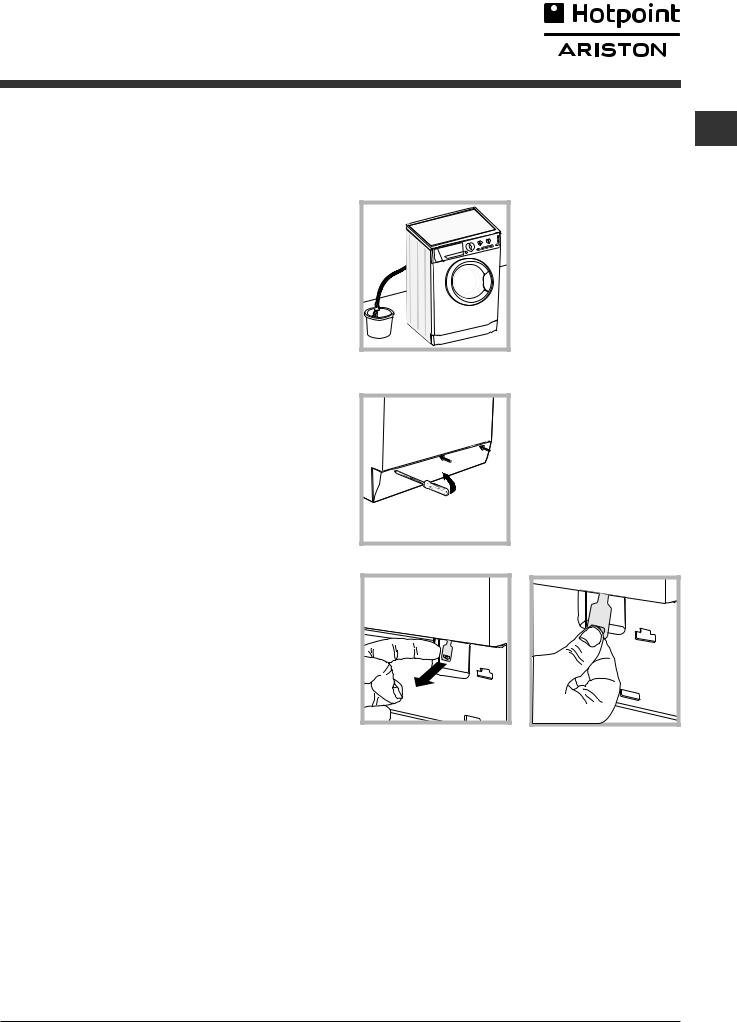
Precautions and tips
This washing machine was designed and constructed in accordance with international safety regulations. The following information is provided for safety reasons and must therefore be read carefully.
General safety
•This appliance was designed for domestic use only.
•The washing machine must only be used by adults, in accordance with the instructions provided in this manual.
•Do not touch the machine when barefoot or with wet or damp hands or feet.
•Do not pull on the power supply cable when unplugging the appliance from the electricity socket. Hold the plug and pull.
•Do not open the detergent dispenser drawer while the machine is in operation.
•Do not touch the drained water as it may reach extremely high temperatures.
•Never force the porthole door. This could damage the safety lock mechanism designed to prevent accidental opening.
•If the appliance breaks down, do not under any circumstances access the internal mechanisms in an attempt to repair it yourself.
•Always keep children well away from the appliance while it is operating.
•The door can become quite hot during the wash cycle.
•If the appliance has to be moved, work in a group of two or three people and handle it with the utmost care. Never try to do this alone, because the appliance is very heavy.
•Before loading laundry into the washing machine, make sure the drum is empty.
Disposal
•Disposing of the packaging materials: observe local regulations so that the packaging may be re-used.
•The European Directive 2002/96/EC on Waste Electrical and Electronic Equipment, requires that old household electrical appliances must not be disposed of in the normal unsorted municipal waste stream. Old appliances must be collected separately in order to optimise the recovery and recycling of the materials they contain and reduce the impact on human health and the environment. The crossed out "wheeled bin" symbol on the product reminds you of your obligation, that when you dispose of the appliance it must be separately collected.
Consumers should contact their local authority or retailer for information concerning the correct disposal of their old appliance.
Opening the porthole door manually
GB
In the event that it is not possible to open the porthole door due to a powercut, and if you wish to remove the laundry, proceed as follows:
1. remove the plug from
the electrical socket.
2. make sure the water
level inside the machine is

 lower than the door 20
lower than the door 20 

opening; if it is not, remove excess water using the
drain hose, collecting it in a bucket as indicated in the figure.
3. using a screwdriver, remove the cover panel on the lower front part of the washing machine (see figure).
4.pull outwards using the tab as indicated in the figure, until the plastic tie-rod is freed from its stop position; pull downwards and open the door at the same time.
5.reposition the panel, making sure the hooks are securely in place before you push it onto the
appliance.
9
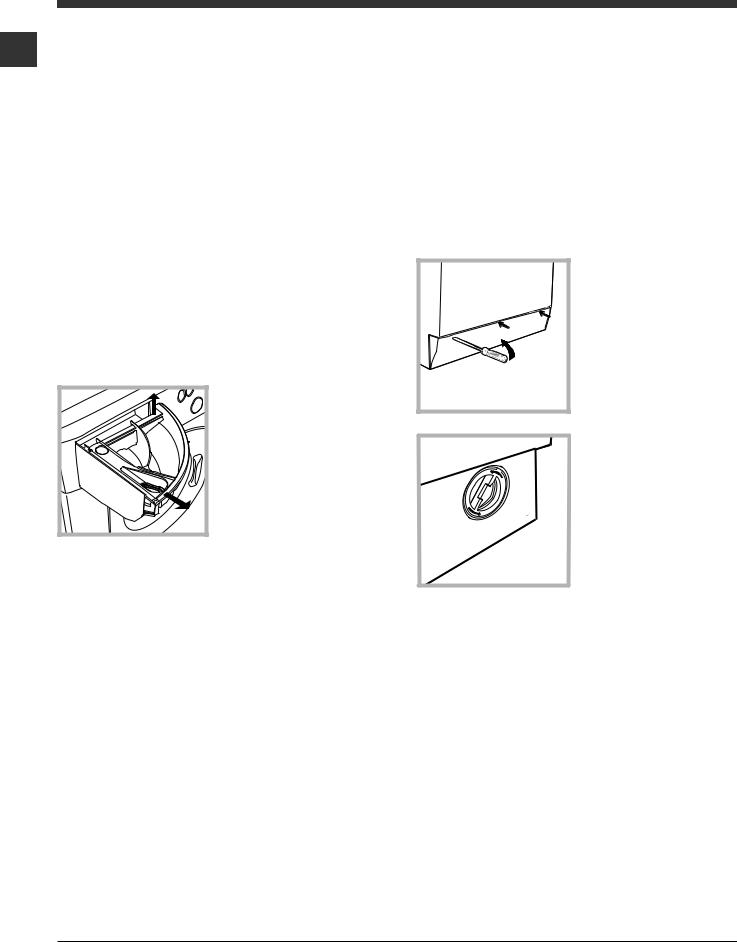
Care and maintenance
Cutting off the water and electricity GB supplies
•Turn off the water tap after every wash cycle. This will limit wear on the hydraulic system inside the washing machine and help to prevent leaks.
•Unplug the washing machine when cleaning it and during all maintenance work.
Cleaning the washing machine
The outer parts and rubber components of the appliance can be cleaned using a soft cloth soaked in lukewarm soapy water. Do not use solvents or abrasives.
Cleaning the detergent dispenser drawer
1 |
2 |
Remove the dispenser by raising it and pulling it out (see figure).
Wash it under running water; this operation should be repeated frequently.
Caring for the door and drum of your appliance
•Always leave the porthole door ajar in order to prevent unpleasant odours from forming.
Cleaning the pump
The washing machine is fitted with a self-cleaning pump which does not require any maintenance. Sometimes, small items (such as coins or buttons) may fall into the pre-chamber which protects the pump, situated in its bottom part.
Make sure the wash cycle has finished and unplug the appliance.
To access the pre-chamber:
1. using a screwdriver, remove the cover panel on the lower front part of the washing machine (see figure);
2. unscrew the lid by rotating it anti-clockwise (see figure): a little water may trickle out. This is perfectly normal;
3.clean the inside thoroughly;
4.screw the lid back on;
5.reposition the panel, making sure the hooks are securely in place before you push it onto the appliance.
Checking the water inlet hose
Check the inlet hose at least once a year. If there are any cracks, it should be replaced immediately: during the wash cycles, water pressure is very strong and a cracked hose could easily split open.
Never use second-hand hoses.
10

Troubleshooting
Your washing machine could fail to work. Before contacting the Technical Assistance Centre (see “Assistance”),
make sure that the problem cannot be not solved easily using the following list. |
GB |
|
|
||
Problem: |
Possible causes / Solutions: |
|
The washing machine does not switch on.
The wash cycle does not start.
•The appliance is not plugged into the socket fully, or is not making contact.
•There is no power in the house.
•The washing machine door is not closed properly.
•The ON/OFF button has not been pressed.
•The START/PAUSE button has not been pressed.
•The water tap has not been opened.
•A delayed start has been set (see “Personalisation”).
The washing machine does not take in water (the indicator light for the first wash cycle stage flashes rapidly).
•The water inlet hose is not connected to the tap.
•The hose is bent.
•The water tap has not been opened.
•There is no water supply in the house.
•The pressure is too low.
•The START/PAUSE button has not been pressed.
The washing machine continuously takes in and drains water.
•The drain hose is not fitted at a height between 65 and 100 cm from the floor (see “Installation”).
•The free end of the hose is under water (see “Installation”).
•The wall drainage system is not fitted with a breather pipe.
If the problem persists even after these checks, turn off the water tap, switch the appliance off and contact the Assistance Service. If the dwelling is on one of the upper floors of a building, there may be problems relating to water drainage, causing the washing machine to fill with water and drain continuously. Special anti-draining valves are available in shops and help to avoid this inconvenience.
The washing machine does not drain or spin.
•The wash cycle does not include draining: some wash cycles require the drain phase to be started manually.
•The EASY IRON function has been activated: To complete the wash cycle, press the START/PAUSE button (“Personalisation”).
•The drain hose is bent (see “Installation”).
•The drainage duct is clogged.
The washing machine vibrates a • The drum was not unlocked correctly during installation (see “Installation”). lot during the spin cycle. • The washing machine is not level (see “Installation”).
• The washing machine is trapped between cabinets and walls (see “Installation”).
The washing machine leaks. • The water inlet hose is not screwed on properly (see “Installation”).
•The detergent dispenser drawer is blocked (for cleaning instructions, see “Care and maintenance”).
•The drain hose is not fixed properly (see “Installation”).
The START/PAUSE indicator light (orange) and the function indicator lights flash rapidly.
There is too much foam.
•Switch off the machine and unplug it, wait for approximately 1 minute and then switch it back on again.
If the problem persists, contact the Technical Assistance Service.
•The detergent is not suitable for machine washing (it should display the text “for washing machines” or “hand and machine wash”, or the like).
•Too much detergent was used.
11

Service
Before calling for Assistance:
GB |
• Check whether you can solve the problem alone (see “Troubleshooting”); |
|
|
|
• Restart the programme to check whether the problem has been solved; |
|
• If this is not the case, contact an authorised Technical Assistance Centre using the telephone number |
|
provided on the guarantee certificate. |
|
Always request the assistance of authorised technicians. |
Have the following information to hand:
•the type of problem;
•the appliance model (Mod.);
•the serial number (S/N).
This information can be found on the data plate applied to the rear of the washing machine, and can also be found on the front of the appliance by opening the door.
12

ПдзгЯет чсЮузт
|
|
РЛХНФЗСЙП |
|
СПХЧЩН |
|
|
|
|
|
|
|
||
|
|
|
|
|
|
|
|
|
|
|
|
|
|
|
|
Ресйечьменб |
|
|||
|
|
GR |
||||
|
|
|
|
|
|
|
|
|
ЕгкбфЬуфбуз, 14-15 |
|
|
|
|
GR |
|
|
|
|
|
|
|
БрпухукехбуЯб кбй псйжпнфЯщуз |
|
|
|
|
|
|
|
ХдсбхлйкЭт кбй злекфсйкЭт ухндЭуейт |
|
|
|
|
|
|
|
|
|
|
|
ЕллзнйкЬ |
Рсюфпт кэклпт рлхуЯмбфпт |
|||||
|
|
ФечнйкЬ уфпйчеЯб |
|
|
|
|
|
|
РесйгсбцЮ фпх рлхнфзсЯпх кбй еккЯнзуз |
|
|
||
|
|
еньт рспгсЬммбфпт, 16-17 |
||||
|
|
РЯнбкбт елЭгчпх |
|
|
|
|
|
|
ЕндейкфйкЬ цщфЬкйб |
|
|
|
|
|
|
ЕккЯнзуз еньт рспгсЬммбфпт |
||||
ARXXL 105
РспгсЬммбфб, 18
РЯнбкбт фщн РспгсбммЬфщн
Еобфпмйкеэуейт, 19
ИЭуфе фз иесмпксбуЯб ИЭуфе фп уфэшймп ЛейфпхсгЯет
БрпссхрбнфйкЬ кбй мрпхгЬдб, 20
ИЮкз брпссхрбнфйкюн Кэклпт леэкбнузт РспефпймбуЯб фзт мрпхгЬдбт ЕйдйкЬ спэчб
Уэуфзмб йупуфЬимйузт фпх цпсфЯпх
РспцхлЬоейт кбй ухмвпхлЭт, 21
ГенйкЮ буцЬлейб ДйЬиеуз
Чейспнбкфйкь Ьнпйгмб фзт рьсфбт
УхнфЮсзуз кбй цспнфЯдб, 22
Брпклейумьт неспэ кбй злекфсйкпэ сеэмбфпт Кбибсйумьт фпх рлхнфзсЯпх Кбибсйумьт фпх ухсфбсйпэ брпссхрбнфйкюн ЦспнфЯдб фзт рьсфбт кбй фпх кЬдпх Кбибсйумьт фзт бнфлЯбт
¸легчпт фпх ущлЮнб фспцпдпуЯбт фпх неспэ
БнщмблЯет кбй лэуейт, 23
ХрпуфЮсйоз, 24
13

ЕгкбфЬуфбуз
ЕЯнбй узмбнфйкь нб дйбфзсЮуефе фп егчейсЯдйп бхфь GR гйб нб мрпсеЯфе нб фп ухмвпхлеэеуфе прпйбдЮрпфе
уфйгмЮ. Уе ресЯрфщуз рюлзузт, рбсбчюсзузт Ю мефбкьмйузт, вевбйщиеЯфе ьфй рбсбмЭней мбжЯ ме фп рлхнфЮсйп гйб нб рлзспцпсеЯ фпн нЭп йдйпкфЮфз гйб фз лейфпхсгЯб кбй фйт учефйкЭт рспейдпрпйЮуейт.
ДйбвЬуфе рспуекфйкЬ фйт пдзгЯет: хрЬсчпхн узмбнфйкЭт рлзспцпсЯет гйб фзн егкбфЬуфбуз, фз чсЮуз кбй фзн буцЬлейб.
БрпухукехбуЯб кбй псйжпнфЯщуз
БрпухукехбуЯб
1.БрпухукехЬуфе фп рлхнфЮсйп.
2.ЕлЭгофе бн фп рлхнфЮсйп Эчей хрпуфеЯ жзмйЭт кбфЬ фз мефбцпсЬ. Бн Эчей хрпуфеЯ жзмйЭт мзн фп ухндЭефе кбй ерйкпйнщнЮуфе ме фпн мефбрщлзфЮ.
3. БцбйсЭуфе фйт ! вЯдет рспуфбуЯбт гйб фз мефбцпсЬ кбй фп лбуфйчЬкй ме фп учефйкь дйбчщсйуфйкь, рпх всЯукпнфбй уфп рЯущ мЭспт (влЭре ейкьнб).
4.КлеЯуфе фйт прЭт ме фб рлбуфйкЬ рюмбфб рпх убт рбсЭчпнфбй.
5.ДйбфзсеЯуфе кбй фб фсЯб фемЬчйб: бн фп рлхнфЮсйп чсейбуфеЯ нб мефбцесиеЯ, иб рсЭрей нб обнбмпнфбсйуфпэн.
Пй ухукехбуЯет ден еЯнбй рбйчнЯдйб гйб мйксЬ рбйдйЬ.
ЕхихгсЬммйуз
1. ЕгкбфбуфЮуфе фп рлхнфЮсйп уе Энб дЬредп ерЯредп кбй бниекфйкь, чщсЯт нб фп бкпхмрЮуефе уе фпЯчпхт, Эрйрлб Ю Ьллп.
2. Бн фп дЬредп ден еЯнбй брьлхфб псйжпнфйщмЭнп, бнфйуфбимЯуфе фйт
бнщмблЯет вйдюнпнфбт Ю
оевйдюнпнфбт фб рсьуийб рпдбсЬкйб (влЭре ейкьнб). З гщнЯб клЯузт, мефсзмЭнз уфзн ерйцЬнейб есгбуЯбт, ден рсЭрей нб оереснЬей фйт 2°.
Мйб цспнфйумЭнз псйжпнфЯщуз рспудЯдей уфбиесьфзфб уфз мзчбнЮ кбй брпупвеЯ дпнЮуейт, ипсэвпхт кбй мефбфпрЯуейт кбфЬ фз лейфпхсгЯб. Уе ресЯрфщуз мпкЭфбт Ю фЬрзфб, схимЯуфе фб рпдбсЬкйб Эфуй юуфе нб хцЯуфбфбй кЬфщ брь фп рлхнфЮсйп бскефьт чюспт гйб фпн бесйумь.
ХдсбхлйкЭт кбй злекфсйкЭт ухндЭуейт
Уэндеуз фпх ущлЮнб фспцпдпуЯбт фпх неспэ
1. ЕйуЬгефе фзн фуймпэчб A уфп Ьксп фпх ущлЮнб фспцпдпуЯбт кбй вйдюуфе фз уе Энб кспхнь ксэпх неспэ ме уфьмйп
A |
урейсюмбфпт 3/4 gas |
|
|
|
(влЭре ейкьнб). |
|
Рсйн фз уэндеуз, бцЮуфе |
|
нб фсЭоей фп несь мЭчсй |
|
нб гЯней дйбхгЭт. |
|
2. УхндЭуфе фп ущлЮнб |
|
фспцпдпуЯбт уфп |
|
рлхнфЮсйп вйдюнпнфЬт |
|
фпн уфзн бнфЯуфпйчз |
|
еЯупдп неспэ, уфп рЯущ |
|
мЭспт ерЬнщ деойЬ |
|
(влЭре ейкьнб). |
3. РспуЭофе юуфе уфп ущлЮнб нб мзн хрЬсчпхн пэфе рфхчюуейт, пэфе уфенюуейт.
З рЯеуз неспэ фпх кспхнпэ рсЭрей нб кхмбЯнефбй мефбоэ фщн фймюн фпх рЯнбкб ФечнйкЬ уфпйчеЯб
(влЭре уелЯдб дЯрлб).
Бн фп мЮкпт фпх ущлЮнб фспцпдпуЯбт ден ербскеЯ, брехихниеЯфе уе Энб ейдйкехмЭнп кбфЬуфзмб Ю уе Энб еопхуйпдпфзмЭнп фечнйкь.
Мз чсзуймпрпйеЯфе рпфЭ чсзуймпрпйзмЭнпхт ущлЮнет.
ЧсзуймпрпйеЯфе екеЯнпхт рпх убт рбсЭчпнфбй ме фз мзчбнЮ.
14

Уэндеуз фпх ущлЮнб бдейЬумбфпт |
|
|
УхндЭуфе бдейЬумбфпт, |
|
чщсЯт нб фпн дйрлюуефе, |
|
уе Энбн бгщгь |
|
еккЭнщузт Ю уе мйб |
|
ерйфпЯчйб брпчЭфехуз уе |
65 - 100 cm |
брьуфбуз брь 65 Эщт |
|
|
|
100 cm брь фп Эдбцпт. |
Мз чсзуймпрпйеЯфе рспекфЬуейт кбй рплэрсйжб.
GR
Фп кблюдйп ден рсЭрей нб цЭсей рфхчЭт Ю нб еЯнбй ухмрйеумЭнп.
Фп кблюдйп фспцпдпуЯбт рсЭрей нб бнфйкбиЯуфбфбй мьнп брь еопхуйпдпфзмЭнпхт фечнйкпэт.
РспупчЮ! З ерйчеЯсзуз брпрпйеЯфбй кЬие ехиэнзт уе ресЯрфщуз рпх ден фзспэнфбй бхфпЯ пй кбньнет.
ДйбцпсефйкЬ брпиЭуфе фпн уфп чеЯлпт еньт нйрфЮсб Ю мйбт лекЬнзт, дЭнпнфбт фпн пдзгь рпх убт рбсЭчефбй уфпнкспхнь (влЭре ейкьнб). Фп елеэиесп Ьксп фпх ущлЮнб бдейЬумбфпт ден рсЭрей нб рбсбмЭней вхийумЭнп уфп несь.
Ден ухнйуфЬфбй з чсЮуз рспекфЬуещн ущлЮнщн. Бн брбйфеЯфбй, з рспЭкфбуз рсЭрей нб Эчей фзн Ядйб дйЬмефсп фпх бсчйкпэ ущлЮнб кбй нб мзн оереснЬей фб 150 cm.
ЗлекфсйкЮ уэндеуз
Рсйн ейуЬгефе фп вэумб уфзн злекфсйкЮ рсЯжб, вевбйщиеЯфе ьфй:
•з рсЯжб дйбиЭфей геЯщуз кбй фзсеЯ фйт ек фпх ньмпх рспдйбгсбцЭт.
•З рсЯжб нб еЯнбй уе иЭуз нб хрпцЭсей фп мЭгйуфп цпсфЯп йучэпт фзт мзчбнЮт, рпх бнбцЭсефбй уфпн рЯнбкб Фечнйкюн уфпйчеЯщн (влЭре дЯрлб).
•З фЬуз фспцпдпуЯбт нб кхмбЯнефбй мефбоэ фщн фймюн рпх бнбцЭспнфбй уфпн рЯнбкб Фечнйкюн уфпйчеЯщн (влЭре дЯрлб).
•З рсЯжб нб еЯнбй ухмвбфЮ ме фп вэумб фпх рлхнфзсЯпх. Уе бнфЯиефз ресЯрфщуз, бнфйкбфбуфЮуфе фзн рсЯжб Ю фп вэумб.
Фп рлхнфЮсйп ден егкбиЯуфбфбй уе бнпйчфь чюсп, бкьмз кбй бн п чюспт еЯнбй кблхммЭнпт, дйьфй еЯнбй рплэ ерйкЯндхнп нб фп бцЮнефе екфеиеймЭнп уе вспчЮ кбй кбкпкбйсЯб.
Ме фзн егкбфЬуфбуз фпх рлхнфзсЯпх, з рсЯжб сеэмбфпт рсЭрей нб еЯнбй еэкплб рспувЬуймз.
Рсюфпт кэклпт рлхуЯмбфпт
МефЬ фзн егкбфЬуфбуз, рсйн фз чсЮуз, дйенесгЮуфе Энб кэклп рлхуЯмбфпт ме брпссхрбнфйкь кбй чщсЯт спэчб иЭфпнфбт фп рсьгсбммб 1.
ФечнйкЬ уфпйчеЯб
МпнфЭлп |
ARXXL 105 |
|
|
|
|
|
рлЬфпт cm 59,5 |
|
ДйбуфЬуейт |
ýøïò cm 85 |
|
|
вЬипт cm 56,5 |
|
|
|
|
Чщсзфйкьфзфб |
áðü 1 Ýùò 7 kg |
|
|
|
|
ЗлекфсйкЭт |
ВлЭре фзн рйнбкЯдб |
|
ухндЭуейт |
чбсбкфзсйуфйкюн ерЯ фзт мзчбнЮт |
|
|
|
|
|
мЭгйуфз рЯеуз 1 MPa (10 bar) |
|
УхндЭуейт неспэ |
ЕлЬчйуфз рЯеуз 0,05 MPa (0,5 bar) |
|
|
чщсзфйкьфзфб фпх кЬдпх 52 лЯфсб |
|
|
|
|
Фбчэфзфб |
мЭчсй 1000 уфспцЭт фп лерфь |
|
уфхшЯмбфпт |
||
|
||
|
|
|
РспгсЬммбфб |
|
|
елЭгчпх уэмцщнб |
рсьгсбммб 6; иесмпксбуЯб 60°C; |
|
ме фпн кбнпнйумь |
екфелпэменп ме 7 kg мрпхгЬдбт. |
|
EN 60456 |
|
З ухукехЮ бхфЮ еЯнбй уэмцщнз ме фйт бкьлпхиет пйнпфйкЭт ПдзгЯет:
-73/23/CEE фзт 19/02/73 (ЧбмзлЮ ФЬуз) кбй мефбгенЭуфесет фспрпрпйЮуейт
-89/336/CEE фзт 03/05/89 (ЗлекфспмбгнзфйкЮ Ухмвбфьфзфб)
кбй мефбгенЭуфесет фспрпрпйЮуейт - 2002/96/CE
15
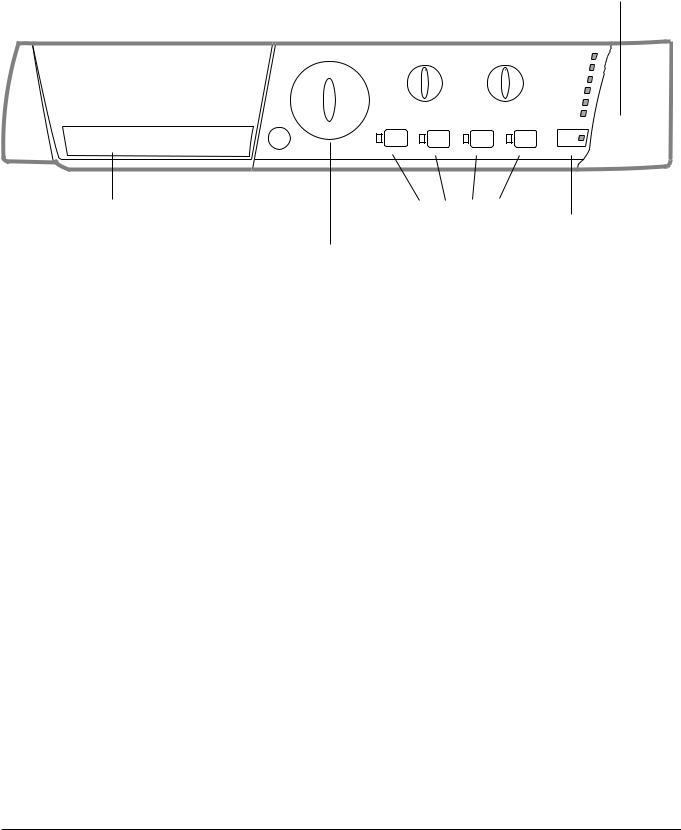
РесйгсбцЮ фпх рлхнфзсЯпх кбй еккЯнзуз еньт рспгсЬммбфпт
|
|
|
|
|
|
|
|
|
|
|
|
|
|
|
|
|
|
|
|
|
|
|
РЯнбкбт елЭгчпх |
|
|
|
|
|
|
|
ЕНДЕЙКФЙКБ ЦЩФБКЙБ |
|
|||||||||||
|
|
|
|
|
|
|
|||||||||||||||
GR |
|
|
|
|
|
|
|
|
|
|
РСПЩИЗУЗУ КХКЛПХ/ |
|
|||||||||
|
|
|
|
|
|
|
|
|
|
|
КБИХУФЕСЗМЕНЗУ |
|
|||||||||
|
|
|
|
|
|
|
|
|
|
|
ЕККЙНЗУЗУ |
|
|
|
|
|
|||||
|
|
|
|
|
ЕрйлпгЭбт |
|
|
|
|
|
|
|
|
Ендейкфйкь цщфЬкй |
|||||||
|
|
|
|
|
|
|
|||||||||||||||
|
|
|
|
|
|
|
|
РПСФБ |
|
||||||||||||
|
|
|
|
|
УФХШЙМБФПУ |
|
|
||||||||||||||
КпхмрЯ |
|
|
|
БУЦБЛЙУМЕНЗ |
|||||||||||||||||
|
|
|
|
|
|
|
|||||||||||||||
БНБММБФПУ/ |
ЕрйлпгЭбт |
|
|
|
|
|
|
|
|
|
|
|
|
|
|
||||||
|
|
|
|
|
|
|
|
|
|
|
|
|
|
||||||||
УВЗУЙМБФПУ |
|
|
|
|
|
|
|
|
|
|
|
|
|
|
|||||||
ИЕСМПКСБУЙБ |
|
|
|
|
|
|
|
|
|
|
|
|
|
|
|||||||
|
|
|
|
|
|
|
|
|
|
|
|
|
|
|
|
|
|
|
|||
|
|
|
|
|
|
|
|
|
|
|
|
|
|
|
|
|
|
|
|
|
|
|
|
|
|
|
|
|
|
|
|
|
|
|
|
|
|
|
|
|
|
|
|
|
|
|
|
|
|
|
|
|
|
|
|
|
|
|
|
|
|
|
|
|
|
|
|
|
|
|
|
|
|
|
|
|
|
|
|
|
|
|
|
|
|
|
|
|
|
|
|
|
|
|
|
|
|
|
|
|
|
|
|
|
|
|
|
|
|
|
|
|
|
|
|
|
|
|
|
|
|
|
|
|
|
|
|
|
|
|
|
|
|
|
|
|
|
|
|
|
|
|
|
|
|
|
|
|
|
|
|
|
|
|
|
|
|
|
|
|
|
|
|
|
|
|
|
|
|
|
|
|
|
|
|
|
|
|
|
|
|
|
|
|
|
|
|
|
|
|
|
|
|
|
|
|
|
|
|
|
|
|
|
|
|
|
|
|
|
|
|
|
|
|
|
|
|
|
|
|
|
|
|
|
|
|
|
|
|
|
|
|
|
|
|
|
|
|
|
|
|
ИЮкз брпссхрбнфйкюн |
|
КпхмрЯ ме |
|
ендейкфйкь цщфЬкй |
|
|
|
|
|
Кпхмрй Ь ме ендейкфйкЬ |
ЕККЙНЗУЗ/ |
ЕрйлпгЭбт |
цщфЬкйб |
РБХУЗ |
ЛЕЙФПХСГЙБУ |
|
|
РСПГСБММБФЩН |
|
|
|
|
ИЮкз брпссхрбнфйкюн: гйб фзн рспуиЮкз брпссхрбнфйкюн кбй рсьуиефщн (влЭре «БрпссхрбнфйкЬ кбй мрпхгЬдб»).
Уфп еущфесйкь фзт иЮкзт брпссхрбнфйкюн всЯукефбй фп бнбльгйп, уфп прпЯп мрпсеЯфе, бнЬ рЬуб уфйгмЮ, нб ухмвпхлехфеЯфе Энб ухниефйкь учЭдйп фщн рспгсбммЬфщн.
КпхмрЯ БНБММБФПУ/УВЗУЙМБФПУ: Гйб нб бнЬшефе Ю нб увЮуефе фп рлхнфЮсйп.
ЕрйлпгЭбт РСПГСБММБФЩН: гйб нб иЭуефе фб рспгсЬммбфб. КбфЬ фз дйЬскейб фпх рспгсЬммбфпт п ерйлпгЭбт рбсбмЭней бкЯнзфпт.
Кпхмрй Ь ме ендейкфйкЬ цщфЬкйб ЛЕЙФПХСГЙБУ: гйб нб ерйлЭоефе фйт дйбиЭуймет лейфпхсгЯет. Фп учефйкь ме фзн ерйлегеЯуб лейфпхсгЯб ендейкфйкь цщфЬкй иб рбсбмеЯней бнбммЭнп.
ЕрйлпгЭбт УФХШЙМБФПУ: гйб нб иЭуефе фп уфэшймп Ю нб фп брпклеЯуефе (влЭре “Еобфпмйкеэуейт”).
ЕрйлпгЭбт ИЕСМПКСБУЙБ: гйб нб иЭуефе фз иесмпксбуЯб Ю фп рлэуймп уе ксэп несь (влЭре «Еобфпмйкеэуейт»).
ЕНДЕЙКФЙКБ ЦЩФБКЙБ РСПЩИЗУЗУ КХКЛПХ/ КБИХУФЕСЗМЕНЗУ ЕККЙНЗУЗУ: гйб нб бкплпхиеЯфе фзн кбфЬуфбуз рспьдпх фпх рспгсЬммбфпт рлхуЯмбфпт.
Фп бнбммЭнп ендейкфйкь цщфЬкй деЯчней фзн уе еоЭлйоз цЬуз.
Бн фЭизке з лейфпхсгЯб “КбихуфесзмЭнз еккЯнзуз”, иб деЯчнпхн фпн чсьнп рпх хрплеЯрефбй гйб фзн Энбсоз фпх рспгсЬммбфпт (влЭре уелЯдб дЯрлб).
Ендейкфйкь цщфЬкй РПСФБ БУЦБЛЙУМЕНЗ: гйб нб кбфблЬвефе бн з рьсфб бнпЯгей (влЭре уелЯдб дЯрлб).
КпхмрЯ ме ендейкфйкь цщфЬкй ЕККЙНЗУЗ/РБХУЗ: гйб фзн еккЯнзуз фщн рспгсбммЬфщн Ю фзн рспущсйнЮ дйбкпрЮ фпхт.
УЗМЕЙЩУЗ: гйб нб иЭуефе уе рбэуз фп уе еоЭлйоз рлэуймп, рйЭуфе фп кпхмрЯ бхфь, фп учефйкь ендейкфйкь цщфЬкй иб бнЬшей ме рпсфпкблЯ чсюмб еню екеЯнп фзт уе еоЭлйозт цЬузт иб еЯнбй ухнечют бнбммЭнп. Бн фп ендейкфйкь цщфЬкй РПСФБ БУЦБЛЙУМЕНЗ  увЮуей, мрпсеЯфе нб бнпЯоефе фзн рьсфб.
увЮуей, мрпсеЯфе нб бнпЯоефе фзн рьсфб.
Гйб нб оекйнЮуей рЬлй фп рлэуймп брь фп узмеЯп дйбкпрЮт, рбфЮуфе ек нЭпх фп кпхмрЯ бхфь.
16
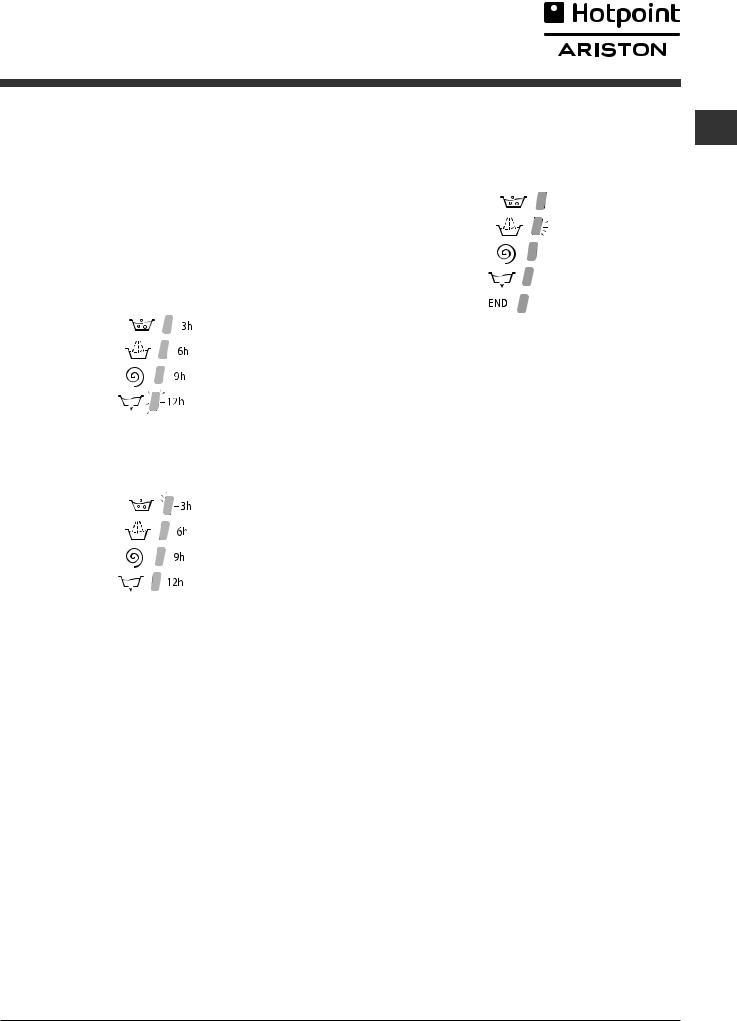
ЕндейкфйкЬ цщфЬкйб
Фб ендейкфйкЬ цщфЬкйб рбсЭчпхн узмбнфйкЭт рлзспцпсЯет.
Íá ôé ìáò ëÝíå:
КбихуфесзмЭнз еккЯнзуз
Бн енесгпрпйЮизке з лейфпхсгЯб “КбихуфесзмЭнз еккЯнзуз” (влЭре “Еобфпмйкеэуейт”), бцпэ еккйнЮуефе фп рсьгсбммб, иб бсчЯуей нб бнбвпувЮней фп ендейкфйкь цщфЬкй фп учефйкь ме фзн ерйлегмЭнз кбихуфЭсзуз:
Ме фп рЭсбумб фпх чсьнпх иб брейкпнЯжефбй з хрплейрьменз кбихуфЭсзуз, ме фп учефйкь ендейкфйкь цщфЬкй нб бнбвпувЮней.
Бцпэ дйбнхиеЯ з ерйлегеЯуб кбихуфЭсзуз фп ендейкфйкь цщфЬкй рпх бнбвпувЮней иб увЮуей кбй иб бсчЯуей фп феиЭн рсьгсбммб.
ЕндейкфйкЬ цщфЬкй цЬузт уе еоЭлйоз
КбфЬ фпн ерйихмзфь кэклп рлхуЯмбфпт, фб ендейкфйкЬ GR цщфЬкйб иб бнЬшпхн рсппдехфйкЬ гйб нб деЯопхн фзн кбфЬуфбуз рспюизузт:
Рлэуймп
ОЭвгблмб
Уфэшймп
¢дейбумб
ФЭлпт РлхуЯмбфпт
КпхмрйЬ лейфпхсгЯбт кбй учефйкЬ ендейкфйкЬ цщфЬкйб
ЕрйлЭгпнфбт мйб лейфпхсгЯб фп учефйкь ендейкфйкь цщфЬкй иб цщфйуфеЯ.
Бн з ерйлегмЭнз лейфпхсгЯб ден еЯнбй ухмвбфЮ ме фп феиЭн рсьгсбммб фп учефйкь ендейкфйкь цщфЬкй иб бнбвпувЮней кбй з лейфпхсгЯб ден иб енесгпрпйзиеЯ. Уфзн ресЯрфщуз рпх феиеЯ мйб лейфпхсгЯб мз ухмвбфЮ ме мйб Ьллз рпх ерйлЭчизке рспзгпхмЭнщт иб рбсбмеЯней енесгЮ мьнп з фелехфбЯб ерйлпгЮ.
 Ендейкфйкь цщфЬкй буцблйумЭнзт рьсфбт
Ендейкфйкь цщфЬкй буцблйумЭнзт рьсфбт
Фп бнбммЭнп ендейкфйкь цщфЬкй деЯчней ьфй з рьсфб еЯнбй буцблйумЭнз гйб фзн рбсемрьдйуз фхчбЯщн бнпйгмЬфщн. Гйб фзн брпцхгЮ жзмйюн рсЭрей нб ресймЭнефе нб увЮуей фп ендейкфйкь цщфЬкй рсйн фп Ьнпйгмб фзт рьсфбт.
УЗМЕЙЩУЗ: бн еЯнбй енесгЮ з лейфпхсгЯб “КбихуфесзмЭнз еккЯнзуз” з рьсфб ден мрпсеЯ нб бнпЯоей, гйб нб фзн бнпЯоефе иЭуфе фз мзчбнЮ уе рбэуз рйЭжпнфбт фп кпхмрЯ ЕККЙНЗУЗ/РБХУЗ.
Фп фбчэ бнбвпувЮуймп фпх цщфьт ЕККЙНЗУЗ/РБХУЗ (рпсфпкблЯ) фбхфьчспнб ме екеЯнп фщн лейфпхсгйюн ерйузмбЯней мйб бнщмблЯб (влЭре “БнщмблЯет кбй лэуейт”).
ЕккЯнзуз еньт рспгсЬммбфпт
1. БнЬшфе фп рлхнфЮсйп рйЭжпнфбт фп кпхмрЯ БНБММБ/УВЗУЙМП. ¼лб фб ендейкфйкЬ цщфЬкй иб бнЬшпхн месйкЬ дехфесьлерфб, мефЬ иб увЮупхн кбй иб рЬллефбй фп ендейкфйкь цщфЬкй ЕККЙНЗУЗ/РБХУЗ.
2.Цпсфюуфе фз мрпхгЬдб кбй клеЯуфе фзн рьсфб.
3.ИЭуфе ме фпн ерйлпгЭб РСПГСБММБФЩН фп ерйихмзфь рсьгсбммб.
4.ИЭуфе фз иесмпксбуЯб рлхуЯмбфпт (влЭре «Еобфпмйкеэуейт»).
5.ИЭуфе фзн фбчэфзфб уфхшЯмбфпт (влЭре «Еобфпмйкеэуейт»).
6.Чэуфе брпссхрбнфйкь кбй рсьуиефб (влЭре «БрпссхрбнфйкЬ кбй мрпхгЬдб»).
7.ЕрйлЭоефе фйт дйбиЭуймет лейфпхсгЯет.
8.ЕккйнЮуфе фп рсьгсбммб рйЭжпнфбт фп кпхмрЯ ЕККЙНЗУЗ/РБХУЗ кбй фп учефйкь ендейкфйкь цщфЬкй иб рбсбмеЯней бнбммЭнп ухнечют ме рсЬуйнп чсюмб.
Гйб нб бкхсюуефе фпн феиЭнфб кэклп иЭуфе фз мзчбнЮ уе рбэуз рйЭжпнфбт фп кпхмрЯ ЕККЙНЗУЗУ/РБХУЗУ кбй ерйлЭофе Энб нЭп кэклп.
9.Уфп фЭлпт фпх рспгсЬммбфпт иб цщфйуфеЯ фп ендейкфйкь цщфЬкй
 . Фп ендейкфйкь цщфЬкй РПСФБ БУЦБЛЙУМЕНЗ иб увЮуей деЯчнпнфбт ьфй з рьсфб мрпсеЯ нб бнпЯоей. ВгЬлфе фз мрпхгЬдб кбй бцЮуфе фзн рьсфб мйуьклейуфз гйб нб уфегнюуей п кЬдпт.
. Фп ендейкфйкь цщфЬкй РПСФБ БУЦБЛЙУМЕНЗ иб увЮуей деЯчнпнфбт ьфй з рьсфб мрпсеЯ нб бнпЯоей. ВгЬлфе фз мрпхгЬдб кбй бцЮуфе фзн рьсфб мйуьклейуфз гйб нб уфегнюуей п кЬдпт.
УвЮуфе фп рлхнфЮсйп рйЭжпнфбт фп кпхмрЯ БНБММБ/УВЗУЙМП.
17

РспгсЬммбфб
РЯнбкбт фщн РспгсбммЬфщн
GR |
РспгсЬммбфб |
|
|
МЭгйуфз |
БрпссхрбнфйкЬ |
МЭгйуфп |
|
||
|
|
|
|
||||||
|
|
|
МЭгйуфз |
фбчэфзфб |
ДйЬскейб |
||||
|
|
|
|
|
|
ЦпсфЯп. |
|||
|
|
РесйгсбцЮ фпх РспгсЬµµбфпт |
èåñµïêñ. |
(уфспцЭт |
|
|
|
||
|
|
|
(°C) |
áíÜ |
Лехкбн- |
Рлэуйµп |
Мблбкфйкь |
(Kg) |
кэклпх |
|
|
|
|
|
|||||
|
|
|
|
лерфь) |
ôéêü |
|
|
||
|
|
|
|
|
|
|
|
||
|
|
|
|
|
|
|
|
|
|
|
|
ЕйдйкЬ РспгсЬµµбфб |
|
|
|
|
|
|
|
|
6 |
KХKЛПУ БРПУФЕЙСЩУЗУ: ЛехкЬ еобйсефйкЬ лесщµЭнб. |
90° |
1000 |
l |
l |
l |
7 |
165 |
|
|
|
|
|
|
|
|
|
|
|
6 |
KХKЛПУ БРПУФЕЙСЩУЗУ (1): ЛехкЬ кбй чсщµбфйуфЬ |
60° |
1000 |
- |
l |
l |
7 |
175 |
|
|
бниекфйкЬ, рплэ лесщµЭнб. |
|
|
|
|
|
|
|
|
7 |
БЛЗНХЧФБ: ЧсщµбфйуфЬ ехбЯуизфб лЯгп лесщµЭнб. |
40° |
800 |
- |
l |
l |
4 |
290 |
|
|
|
|
|
|
|
|
|
|
|
8 |
РAХУЗ ГЙБ МЩСБ: ЧсщµбфйуфЬ ехбЯуизфб лЯгп лесщµЭнб. |
40° |
800 |
- |
l |
l |
2 |
118 |
|
|
|
|
|
|
|
|
|
|
|
9 |
РПЙKБМЙУБ |
40° |
600 |
- |
l |
l |
2 |
70 |
|
|
|
|
|
|
|
|
|
|
|
10 |
МЕФБОЩФ¢/ ПХСФºНЕУ: Гйб µефбощфЬ спэчб, вйукьжз, лйнЬ. |
30° |
0 |
- |
l |
l |
2 |
55 |
|
|
|
|
|
|
|
|
|
|
|
11 |
М¢ЛЛЙНБ: Гйб µЬллйнб, cachemire, клр. |
40° |
600 |
- |
l |
l |
1,5 |
55 |
|
|
|
|
|
|
|
|
|
|
|
|
РспгсЬµµбфб гйб ьлет фйт µЭсет |
|
|
|
|
|
|
|
|
1 |
ВБМВБKЕС¢: ЛехкЬ кбй чсщµбфйуфЬ бниекфйкЬ, рплэ |
60° |
1000 |
l |
l |
l |
7 |
130 |
|
|
ëåñùµÝíá. |
|
|
|
|
|
|
|
|
1 |
ВБМВБKЕС¢: (2): ЛехкЬ кбй чсщµбфйуфЬ ехбЯуизфб, рплэ лесщµЭнб. |
40° |
1000 |
l |
l |
l |
7 |
115 |
|
|
|
|
|
|
|
|
|
|
|
2 |
ВБМВБKЕС¢ ЧСЩМБФЙУФ¢ (3): ЛехкЬ лЯгп лесщµЭнб кбй |
40° |
1000 |
l |
l |
l |
7 |
85 |
|
|
ехбЯуизфб чсюµбфб. |
|
|
|
|
|
|
|
|
3 |
УХНИЕФЙKБ: ЧсщµбфйуфЬ бниекфйкЬ, рплэ лесщµЭнб. |
60° |
800 |
- |
l |
l |
3 |
85 |
|
|
|
|
|
|
|
|
|
|
|
3 |
УХНИЕФЙKБ 40°: ЧсщµбфйуфЬ бниекфйкЬ, лЯгп лесщµЭнб. |
40° |
800 |
- |
l |
l |
3 |
70 |
|
|
|
|
|
|
|
|
|
|
|
4 |
ЦСЕУKБСЙУМБ 30': Гйб фп гсЮгпсп цсеукЬсйуµб спэчщн |
|
|
- |
|
|
|
|
|
елбцсЬ лесщµЭнщн (ден ендеЯкнхфбй гйб µЬллйнб, µефбощфЬ |
30° |
800 |
l |
l |
3 |
30 |
||
|
|
кбй спэчб рпх рлЭнпнфбй уфп чЭсй). |
|
|
|
|
|
|
|
|
5 |
ЦСЕУKБСЙУМБ 15': Гйб фп гсЮгпсп цсеукЬсйуµб спэчщн |
|
|
- |
|
|
|
|
|
елбцсЬ лесщµЭнщн (ден ендеЯкнхфбй гйб µЬллйнб, µефбощфЬ |
30° |
800 |
l |
l |
1,5 |
15 |
||
|
|
кбй спэчб рпх рлЭнпнфбй уфп чЭсй). |
|
|
|
|
|
|
|
|
|
ЕрЯ µЭспхт рспгсЬµµбфб |
|
|
|
|
|
|
|
|
A |
ОЕВГБЛМБ ВБМВБKЕСБ |
- |
1000 |
- |
- |
l |
7 |
44 |
|
|
|
|
|
|
|
|
|
|
|
B |
ОЕВГБЛМБ ЕХБЙУИЗФБ |
- |
800 |
- |
- |
l |
3 |
37 |
|
|
|
|
|
|
|
|
|
|
|
C |
ÓÔХШЙМП БНИЕKФЙKБ |
- |
1000 |
- |
- |
- |
7 |
16 |
|
|
|
|
|
|
|
|
|
|
|
D |
УЕХШЙМП ЕХБЙУИЗФБ |
- |
800 |
- |
- |
- |
3 |
12 |
|
|
|
|
|
|
|
|
|
|
|
E |
БМПЧЕÔЕХУЗ НЕСПХ |
- |
0 |
- |
- |
- |
7 |
2 |
|
|
|
|
|
|
|
|
|
|
Фб уфпйчеЯб рпх бнбцЭспнфбй уфпн рЯнбкб еЯнбй ендейкфйкЬ.
ГйбьлбфбTestInstitutes:
1)РсьгсбммбелЭгчпхуэмцщнбмефзнрспдйбгсбцЮEN60456:иЭуфефпрсьгсбммб6уемйбиесмпксбуЯб60°C.
2)Рсьгсбммбвбмвбкесюнмбксэ:иЭуфефпрсьгсбммб1уемйбиесмпксбуЯб40°C.
3)Рсьгсбммбвбмвбкесюнуэнфпмп:иЭуфефпрсьгсбммб2уемйбиесмпксбуЯб40°C.
ЕйдйкЬ рспгсЬммбфб
KХKЛПУ БРПУФЕЙСЩУЗУ (рсьгсбммб 6). ¸нб еохгйбнфйкь рсьгсбммб уе хшзлЭт иесмпксбуЯет рпх рспвлЭрей фз чсЮуз лехкбнфйкпэ уе иесмпксбуЯет бнюфесет фщн 60°C. Гйб фз леэкбнуз чэуфе фп лехкбнфйкь, фб брпссхрбнфйкЬ кбй фб рсьуиефб уфб учефйкЬ дйбмесЯумбфб (влЭре рбсЬгсбцп “УхсфЬсй фщн брпссхрбнфйкюн”).
БЛЗНХЧФБ (рсьгсбммб 7). ЕЯнбй Энбт биьсхвпт кэклпт рпх мрпсеЯ нб дпхлеэей фз нэчфб ьфбн фп фймпльгйп фпх злекфсйкпэ еЯнбй мейщмЭнп. Фп рсьгсбммб мелефЮизке гйб ухниефйкЬ кбй вбмвбкесЬ фпэчб. Уфп фЭлпт фпх кэклпх з мзчбнЮ уфбмбфЬей ме фп несь уфз лекЬнз. Гйб фп уфэшймп кбй фп Ьдейбумб рйЭуфе фп кпхмрЯ ЕККЙНЗУЗ/РБХУЗ, дйбцпсефйкЬ мефЬ брь 8 юсет з мзчбнЮ иб кЬней бхфьмбфб фп уфэшймп кбй фп Ьдейбумб фпх неспэ.
РAХУЗ ГЙБ МЩСБЦСЕУKБСЙУМБ (рсьгсбммб 8). Рсьгсбммб йкбнь нб брпмбксэней фпхт лекЭдет фхрйкпэт фщн мщсюн, дйбуцблЯжпнфбт фзн брпмЬксхнуз фпх брпссхрбнфйкпэ брь фб спэчб гйб фзн брпцхгЮ бллесгйюн уфп ехбЯуизфп дЭсмб фщн мщсюн. П кэклпт мелефЮизке гйб нб мейюней фп вбкфзсйдйбкь цпсфЯп чсзуймпрпйюнфбт мйксьфесз рпуьфзфб неспэ кбй велфйуфпрпйюнфбт фзн ерЯдсбуз фщн ейдйкюн еохгйбнфйкюн рсьуиефщн уфп брпссхрбнфйкь.
Уфп фЭлпт фпх рлхуЯмбфпт з мзчбнЮ дйенесгеЯ бсгЭт ресйуфспцЭт фпх кЬдпх гйб фзн брпцхгЮ дзмйпхсгЯбт рфхчюуещн. Гйб нб фелейюуей п кэклпт рйЭуфе фп кпхмрЯ ЕККЙНЗУЗ/РБХУЗ.
ЦСЕУKБСЙУМБ 30' (рсьгсбммб 4) мелефЮизке гйб фп рлэуймп спэчщн елбцсЬ лесщмЭнщн уе уэнфпмп чсьнп: дйбскеЯ мьнп 30 лерфЬ кбй убт еопйкпнпмеЯ чсьнп кбй енЭсгейб. ИЭфпнфбт фп рсьгсбммб (4 уе 30°C) мрпсеЯфе нб рлэнефе мбжЯ хцЬумбфб дйбцпсефйкЮт цэузт (екфьт мЬллйнщн кбй мефбощфюн) ме Энб мЭгйуфп цпсфЯп 3 kg.
ЦСЕУKБСЙУМБ 15' (рсьгсбммб 5) мелефЮизке гйб фп рлэуймп спэчщн елбцсЬ лесщмЭнщн уе уэнфпмп чсьнп: дйбскеЯ мьнп 15 лерфЬ кбй убт еопйкпнпмеЯ чсьнп кбй енЭсгейб. ИЭфпнфбт фп рсьгсбммб (5 уе 30°C) мрпсеЯфе нб рлэнефе мбжЯ хцЬумбфб дйбцпсефйкЮт цэузт (екфьт мЬллйнщн кбй мефбощфюн) ме Энб мЭгйуфп цпсфЯп 1,5 kg.
18
